Law of Evidence Report: Witness Evidence and Hearsay
VerifiedAdded on 2022/09/23
|15
|4314
|31
Report
AI Summary
This report provides a comprehensive analysis of the Law of Evidence in the United Kingdom, addressing key aspects such as witness testimony and hearsay evidence. Part A of the report delves into the significance of evidence in court cases, emphasizing the importance of witness statements and the application of the Police and Criminal Evidence (PACE) Act 1984, particularly Code D, in the context of witness identification. It examines the guidelines established in the Turnbull case regarding the evaluation of witness identification, and discusses the implications of the witness's prior acquaintance with the suspect and the suspect's silence during police interviews. Part B focuses on the admissibility of hearsay evidence, exploring the reforms introduced by the Criminal Justice Act of 2003 and tracing the historical development of hearsay rules. The report also discusses the exceptions to the hearsay rule, particularly concerning unavailable witnesses and business documents. Overall, the report provides a detailed overview of evidence law, covering relevant legislation, case law, and practical applications.
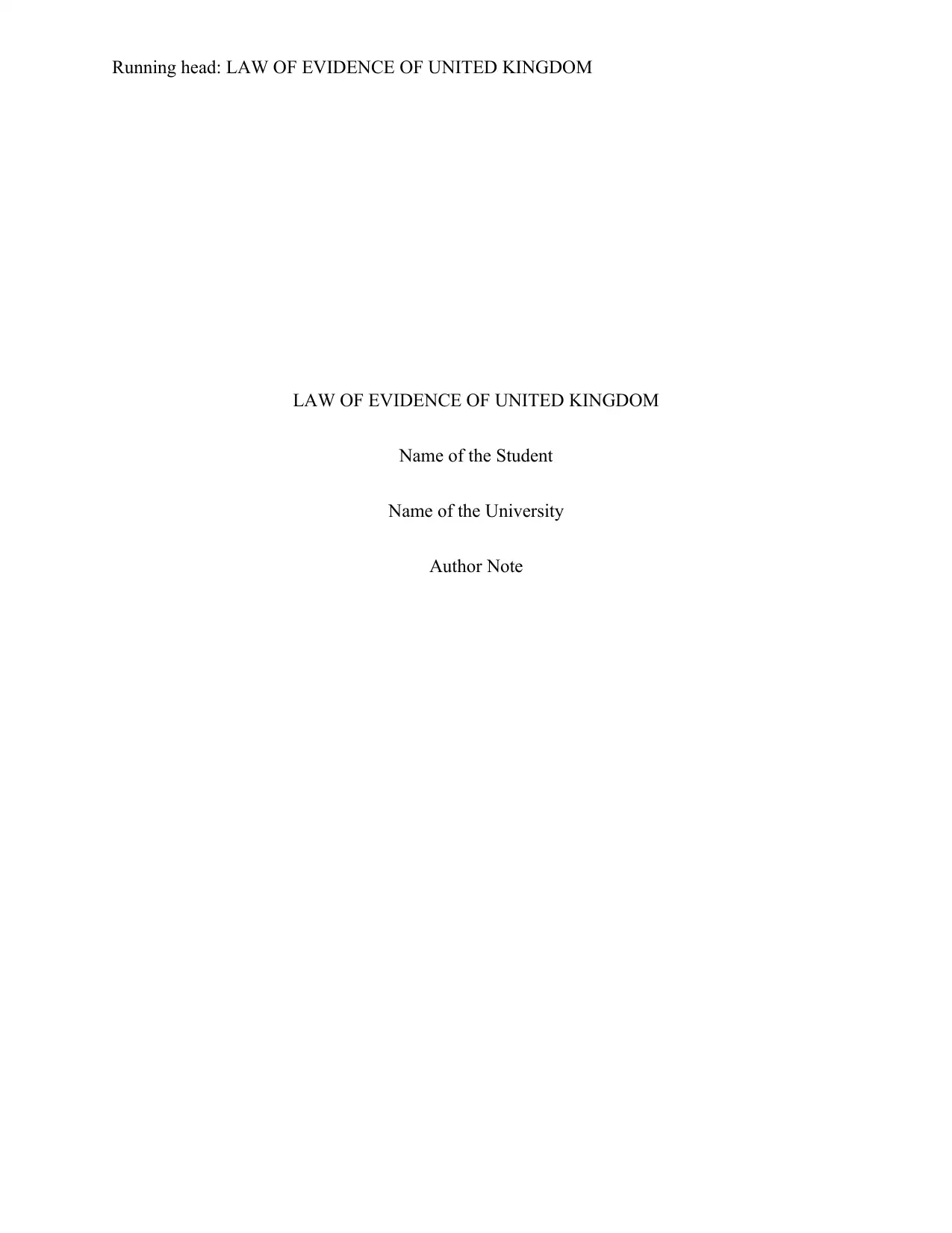
Running head: LAW OF EVIDENCE OF UNITED KINGDOM
LAW OF EVIDENCE OF UNITED KINGDOM
Name of the Student
Name of the University
Author Note
LAW OF EVIDENCE OF UNITED KINGDOM
Name of the Student
Name of the University
Author Note
Paraphrase This Document
Need a fresh take? Get an instant paraphrase of this document with our AI Paraphraser
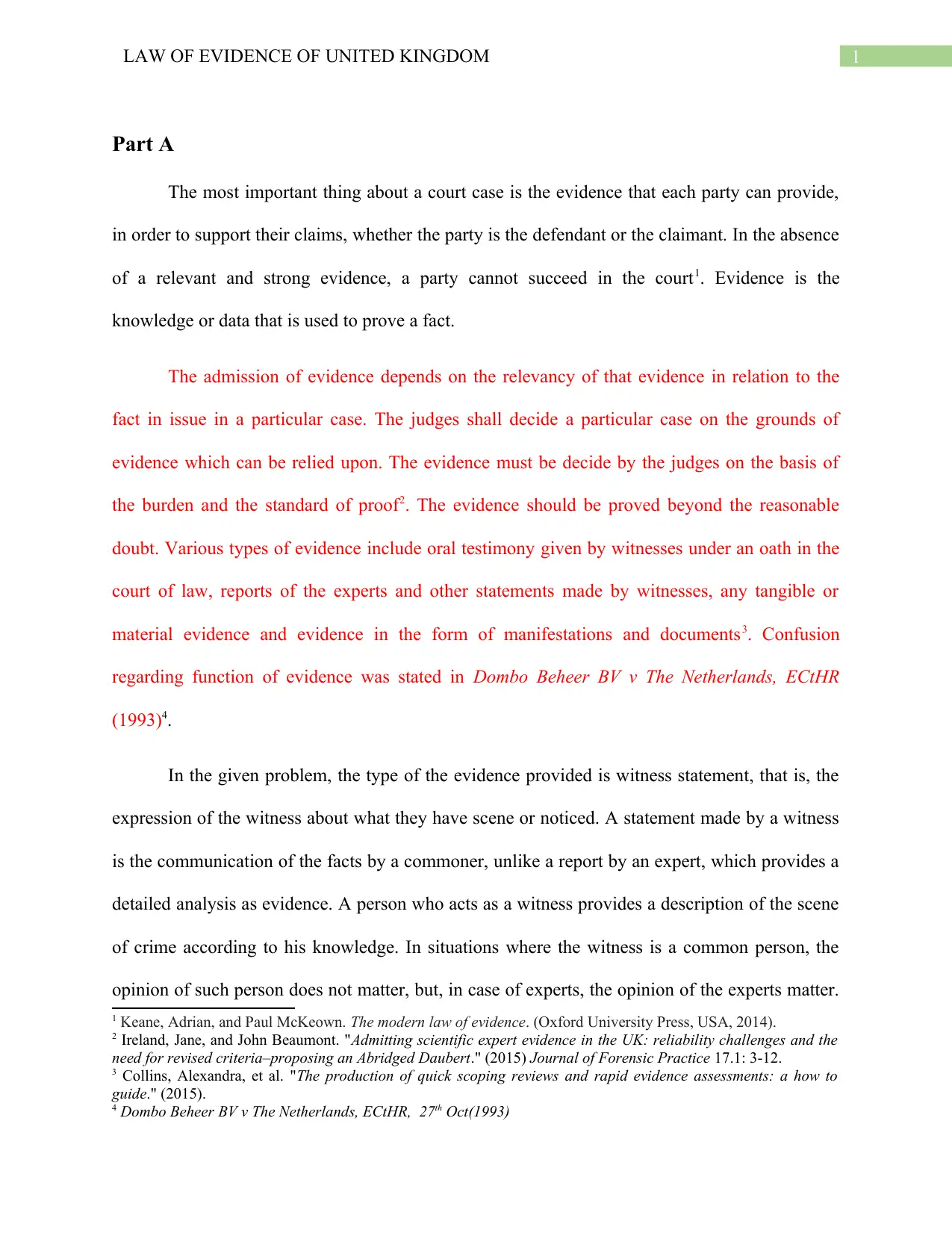
1LAW OF EVIDENCE OF UNITED KINGDOM
Part A
The most important thing about a court case is the evidence that each party can provide,
in order to support their claims, whether the party is the defendant or the claimant. In the absence
of a relevant and strong evidence, a party cannot succeed in the court1. Evidence is the
knowledge or data that is used to prove a fact.
The admission of evidence depends on the relevancy of that evidence in relation to the
fact in issue in a particular case. The judges shall decide a particular case on the grounds of
evidence which can be relied upon. The evidence must be decide by the judges on the basis of
the burden and the standard of proof2. The evidence should be proved beyond the reasonable
doubt. Various types of evidence include oral testimony given by witnesses under an oath in the
court of law, reports of the experts and other statements made by witnesses, any tangible or
material evidence and evidence in the form of manifestations and documents3. Confusion
regarding function of evidence was stated in Dombo Beheer BV v The Netherlands, ECtHR
(1993)4.
In the given problem, the type of the evidence provided is witness statement, that is, the
expression of the witness about what they have scene or noticed. A statement made by a witness
is the communication of the facts by a commoner, unlike a report by an expert, which provides a
detailed analysis as evidence. A person who acts as a witness provides a description of the scene
of crime according to his knowledge. In situations where the witness is a common person, the
opinion of such person does not matter, but, in case of experts, the opinion of the experts matter.
1 Keane, Adrian, and Paul McKeown. The modern law of evidence. (Oxford University Press, USA, 2014).
2 Ireland, Jane, and John Beaumont. "Admitting scientific expert evidence in the UK: reliability challenges and the
need for revised criteria–proposing an Abridged Daubert." (2015) Journal of Forensic Practice 17.1: 3-12.
3 Collins, Alexandra, et al. "The production of quick scoping reviews and rapid evidence assessments: a how to
guide." (2015).
4 Dombo Beheer BV v The Netherlands, ECtHR, 27th Oct(1993)
Part A
The most important thing about a court case is the evidence that each party can provide,
in order to support their claims, whether the party is the defendant or the claimant. In the absence
of a relevant and strong evidence, a party cannot succeed in the court1. Evidence is the
knowledge or data that is used to prove a fact.
The admission of evidence depends on the relevancy of that evidence in relation to the
fact in issue in a particular case. The judges shall decide a particular case on the grounds of
evidence which can be relied upon. The evidence must be decide by the judges on the basis of
the burden and the standard of proof2. The evidence should be proved beyond the reasonable
doubt. Various types of evidence include oral testimony given by witnesses under an oath in the
court of law, reports of the experts and other statements made by witnesses, any tangible or
material evidence and evidence in the form of manifestations and documents3. Confusion
regarding function of evidence was stated in Dombo Beheer BV v The Netherlands, ECtHR
(1993)4.
In the given problem, the type of the evidence provided is witness statement, that is, the
expression of the witness about what they have scene or noticed. A statement made by a witness
is the communication of the facts by a commoner, unlike a report by an expert, which provides a
detailed analysis as evidence. A person who acts as a witness provides a description of the scene
of crime according to his knowledge. In situations where the witness is a common person, the
opinion of such person does not matter, but, in case of experts, the opinion of the experts matter.
1 Keane, Adrian, and Paul McKeown. The modern law of evidence. (Oxford University Press, USA, 2014).
2 Ireland, Jane, and John Beaumont. "Admitting scientific expert evidence in the UK: reliability challenges and the
need for revised criteria–proposing an Abridged Daubert." (2015) Journal of Forensic Practice 17.1: 3-12.
3 Collins, Alexandra, et al. "The production of quick scoping reviews and rapid evidence assessments: a how to
guide." (2015).
4 Dombo Beheer BV v The Netherlands, ECtHR, 27th Oct(1993)
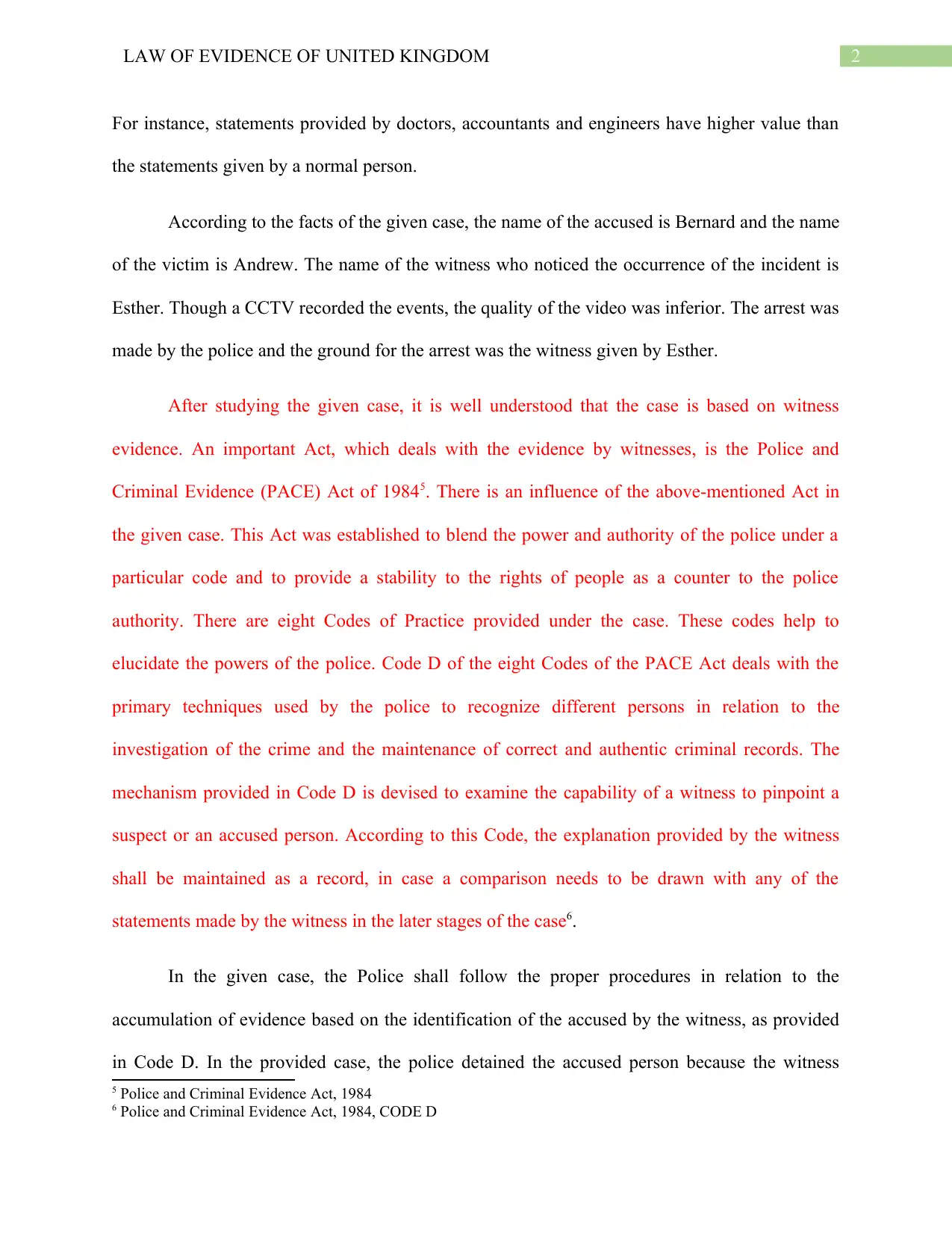
2LAW OF EVIDENCE OF UNITED KINGDOM
For instance, statements provided by doctors, accountants and engineers have higher value than
the statements given by a normal person.
According to the facts of the given case, the name of the accused is Bernard and the name
of the victim is Andrew. The name of the witness who noticed the occurrence of the incident is
Esther. Though a CCTV recorded the events, the quality of the video was inferior. The arrest was
made by the police and the ground for the arrest was the witness given by Esther.
After studying the given case, it is well understood that the case is based on witness
evidence. An important Act, which deals with the evidence by witnesses, is the Police and
Criminal Evidence (PACE) Act of 19845. There is an influence of the above-mentioned Act in
the given case. This Act was established to blend the power and authority of the police under a
particular code and to provide a stability to the rights of people as a counter to the police
authority. There are eight Codes of Practice provided under the case. These codes help to
elucidate the powers of the police. Code D of the eight Codes of the PACE Act deals with the
primary techniques used by the police to recognize different persons in relation to the
investigation of the crime and the maintenance of correct and authentic criminal records. The
mechanism provided in Code D is devised to examine the capability of a witness to pinpoint a
suspect or an accused person. According to this Code, the explanation provided by the witness
shall be maintained as a record, in case a comparison needs to be drawn with any of the
statements made by the witness in the later stages of the case6.
In the given case, the Police shall follow the proper procedures in relation to the
accumulation of evidence based on the identification of the accused by the witness, as provided
in Code D. In the provided case, the police detained the accused person because the witness
5 Police and Criminal Evidence Act, 1984
6 Police and Criminal Evidence Act, 1984, CODE D
For instance, statements provided by doctors, accountants and engineers have higher value than
the statements given by a normal person.
According to the facts of the given case, the name of the accused is Bernard and the name
of the victim is Andrew. The name of the witness who noticed the occurrence of the incident is
Esther. Though a CCTV recorded the events, the quality of the video was inferior. The arrest was
made by the police and the ground for the arrest was the witness given by Esther.
After studying the given case, it is well understood that the case is based on witness
evidence. An important Act, which deals with the evidence by witnesses, is the Police and
Criminal Evidence (PACE) Act of 19845. There is an influence of the above-mentioned Act in
the given case. This Act was established to blend the power and authority of the police under a
particular code and to provide a stability to the rights of people as a counter to the police
authority. There are eight Codes of Practice provided under the case. These codes help to
elucidate the powers of the police. Code D of the eight Codes of the PACE Act deals with the
primary techniques used by the police to recognize different persons in relation to the
investigation of the crime and the maintenance of correct and authentic criminal records. The
mechanism provided in Code D is devised to examine the capability of a witness to pinpoint a
suspect or an accused person. According to this Code, the explanation provided by the witness
shall be maintained as a record, in case a comparison needs to be drawn with any of the
statements made by the witness in the later stages of the case6.
In the given case, the Police shall follow the proper procedures in relation to the
accumulation of evidence based on the identification of the accused by the witness, as provided
in Code D. In the provided case, the police detained the accused person because the witness
5 Police and Criminal Evidence Act, 1984
6 Police and Criminal Evidence Act, 1984, CODE D
⊘ This is a preview!⊘
Do you want full access?
Subscribe today to unlock all pages.

Trusted by 1+ million students worldwide
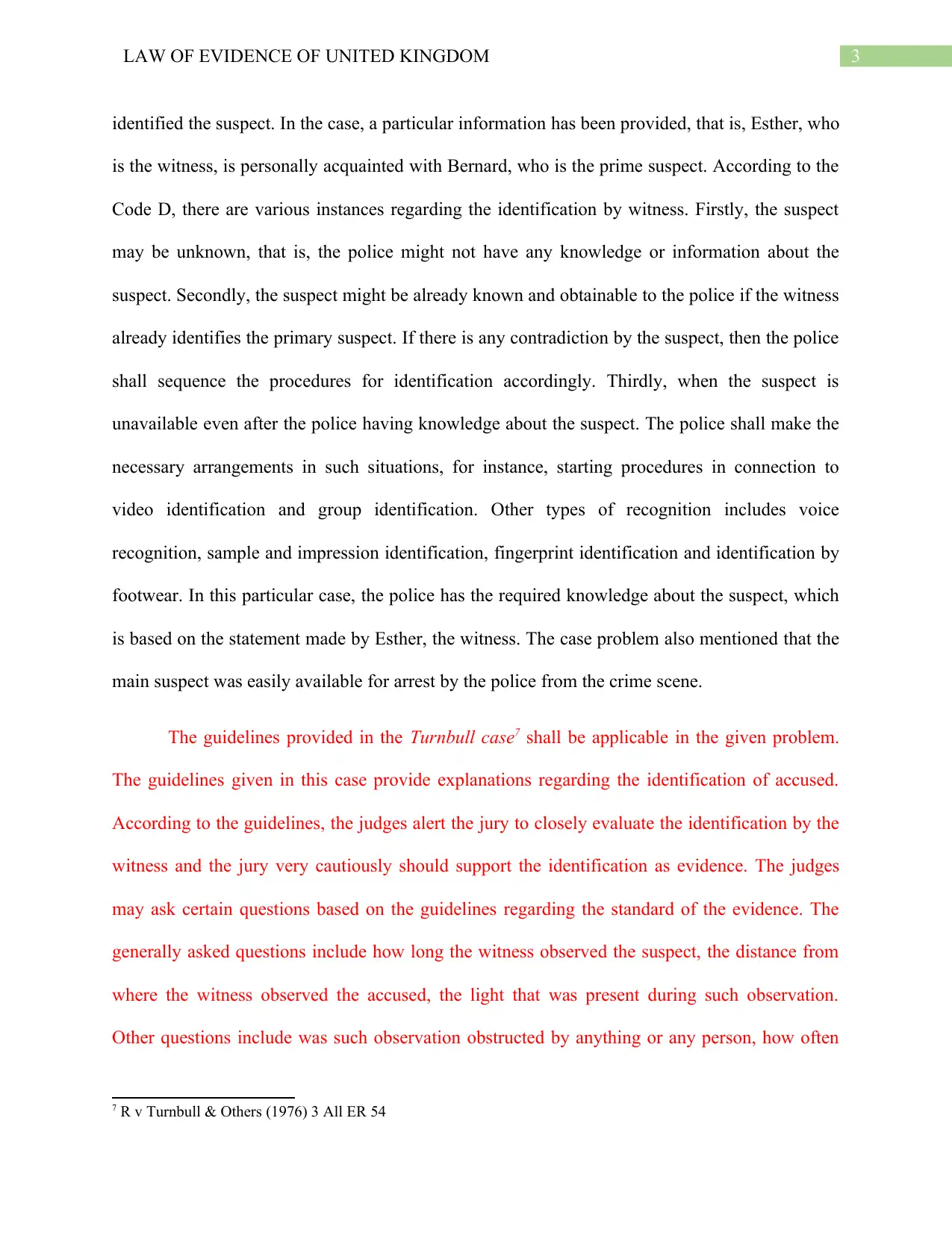
3LAW OF EVIDENCE OF UNITED KINGDOM
identified the suspect. In the case, a particular information has been provided, that is, Esther, who
is the witness, is personally acquainted with Bernard, who is the prime suspect. According to the
Code D, there are various instances regarding the identification by witness. Firstly, the suspect
may be unknown, that is, the police might not have any knowledge or information about the
suspect. Secondly, the suspect might be already known and obtainable to the police if the witness
already identifies the primary suspect. If there is any contradiction by the suspect, then the police
shall sequence the procedures for identification accordingly. Thirdly, when the suspect is
unavailable even after the police having knowledge about the suspect. The police shall make the
necessary arrangements in such situations, for instance, starting procedures in connection to
video identification and group identification. Other types of recognition includes voice
recognition, sample and impression identification, fingerprint identification and identification by
footwear. In this particular case, the police has the required knowledge about the suspect, which
is based on the statement made by Esther, the witness. The case problem also mentioned that the
main suspect was easily available for arrest by the police from the crime scene.
The guidelines provided in the Turnbull case7 shall be applicable in the given problem.
The guidelines given in this case provide explanations regarding the identification of accused.
According to the guidelines, the judges alert the jury to closely evaluate the identification by the
witness and the jury very cautiously should support the identification as evidence. The judges
may ask certain questions based on the guidelines regarding the standard of the evidence. The
generally asked questions include how long the witness observed the suspect, the distance from
where the witness observed the accused, the light that was present during such observation.
Other questions include was such observation obstructed by anything or any person, how often
7 R v Turnbull & Others (1976) 3 All ER 54
identified the suspect. In the case, a particular information has been provided, that is, Esther, who
is the witness, is personally acquainted with Bernard, who is the prime suspect. According to the
Code D, there are various instances regarding the identification by witness. Firstly, the suspect
may be unknown, that is, the police might not have any knowledge or information about the
suspect. Secondly, the suspect might be already known and obtainable to the police if the witness
already identifies the primary suspect. If there is any contradiction by the suspect, then the police
shall sequence the procedures for identification accordingly. Thirdly, when the suspect is
unavailable even after the police having knowledge about the suspect. The police shall make the
necessary arrangements in such situations, for instance, starting procedures in connection to
video identification and group identification. Other types of recognition includes voice
recognition, sample and impression identification, fingerprint identification and identification by
footwear. In this particular case, the police has the required knowledge about the suspect, which
is based on the statement made by Esther, the witness. The case problem also mentioned that the
main suspect was easily available for arrest by the police from the crime scene.
The guidelines provided in the Turnbull case7 shall be applicable in the given problem.
The guidelines given in this case provide explanations regarding the identification of accused.
According to the guidelines, the judges alert the jury to closely evaluate the identification by the
witness and the jury very cautiously should support the identification as evidence. The judges
may ask certain questions based on the guidelines regarding the standard of the evidence. The
generally asked questions include how long the witness observed the suspect, the distance from
where the witness observed the accused, the light that was present during such observation.
Other questions include was such observation obstructed by anything or any person, how often
7 R v Turnbull & Others (1976) 3 All ER 54
Paraphrase This Document
Need a fresh take? Get an instant paraphrase of this document with our AI Paraphraser
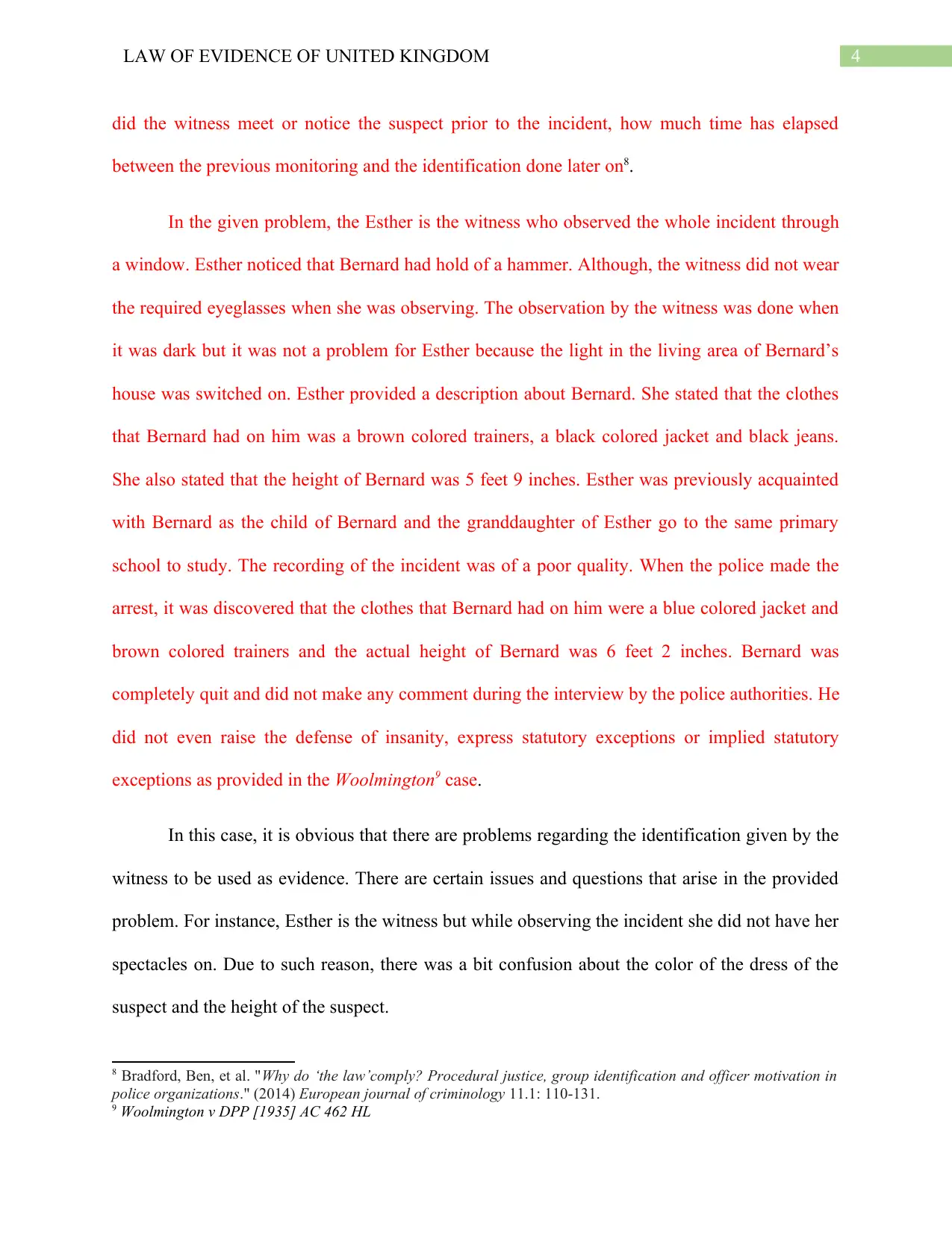
4LAW OF EVIDENCE OF UNITED KINGDOM
did the witness meet or notice the suspect prior to the incident, how much time has elapsed
between the previous monitoring and the identification done later on8.
In the given problem, the Esther is the witness who observed the whole incident through
a window. Esther noticed that Bernard had hold of a hammer. Although, the witness did not wear
the required eyeglasses when she was observing. The observation by the witness was done when
it was dark but it was not a problem for Esther because the light in the living area of Bernard’s
house was switched on. Esther provided a description about Bernard. She stated that the clothes
that Bernard had on him was a brown colored trainers, a black colored jacket and black jeans.
She also stated that the height of Bernard was 5 feet 9 inches. Esther was previously acquainted
with Bernard as the child of Bernard and the granddaughter of Esther go to the same primary
school to study. The recording of the incident was of a poor quality. When the police made the
arrest, it was discovered that the clothes that Bernard had on him were a blue colored jacket and
brown colored trainers and the actual height of Bernard was 6 feet 2 inches. Bernard was
completely quit and did not make any comment during the interview by the police authorities. He
did not even raise the defense of insanity, express statutory exceptions or implied statutory
exceptions as provided in the Woolmington9 case.
In this case, it is obvious that there are problems regarding the identification given by the
witness to be used as evidence. There are certain issues and questions that arise in the provided
problem. For instance, Esther is the witness but while observing the incident she did not have her
spectacles on. Due to such reason, there was a bit confusion about the color of the dress of the
suspect and the height of the suspect.
8 Bradford, Ben, et al. "Why do ‘the law’comply? Procedural justice, group identification and officer motivation in
police organizations." (2014) European journal of criminology 11.1: 110-131.
9 Woolmington v DPP [1935] AC 462 HL
did the witness meet or notice the suspect prior to the incident, how much time has elapsed
between the previous monitoring and the identification done later on8.
In the given problem, the Esther is the witness who observed the whole incident through
a window. Esther noticed that Bernard had hold of a hammer. Although, the witness did not wear
the required eyeglasses when she was observing. The observation by the witness was done when
it was dark but it was not a problem for Esther because the light in the living area of Bernard’s
house was switched on. Esther provided a description about Bernard. She stated that the clothes
that Bernard had on him was a brown colored trainers, a black colored jacket and black jeans.
She also stated that the height of Bernard was 5 feet 9 inches. Esther was previously acquainted
with Bernard as the child of Bernard and the granddaughter of Esther go to the same primary
school to study. The recording of the incident was of a poor quality. When the police made the
arrest, it was discovered that the clothes that Bernard had on him were a blue colored jacket and
brown colored trainers and the actual height of Bernard was 6 feet 2 inches. Bernard was
completely quit and did not make any comment during the interview by the police authorities. He
did not even raise the defense of insanity, express statutory exceptions or implied statutory
exceptions as provided in the Woolmington9 case.
In this case, it is obvious that there are problems regarding the identification given by the
witness to be used as evidence. There are certain issues and questions that arise in the provided
problem. For instance, Esther is the witness but while observing the incident she did not have her
spectacles on. Due to such reason, there was a bit confusion about the color of the dress of the
suspect and the height of the suspect.
8 Bradford, Ben, et al. "Why do ‘the law’comply? Procedural justice, group identification and officer motivation in
police organizations." (2014) European journal of criminology 11.1: 110-131.
9 Woolmington v DPP [1935] AC 462 HL
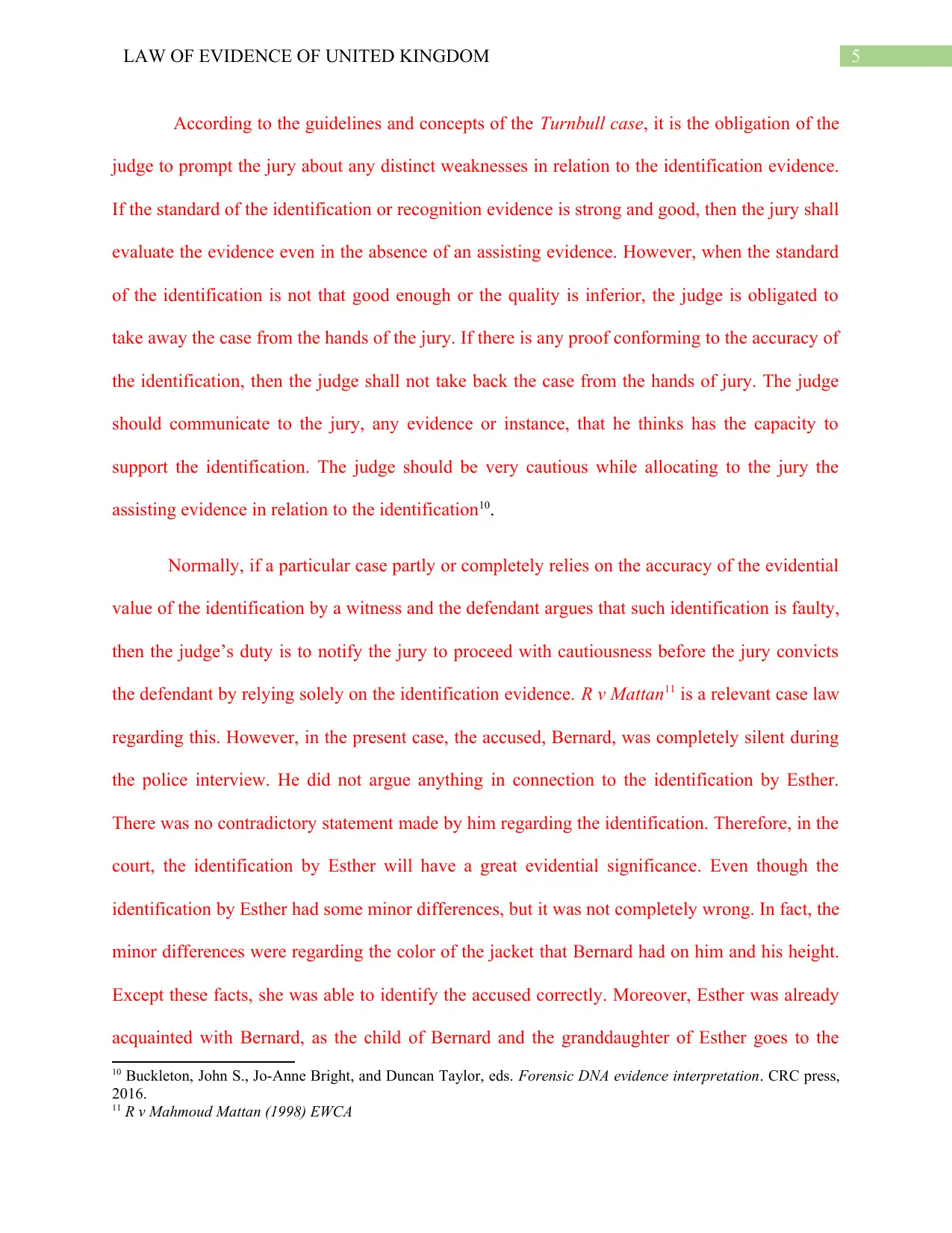
5LAW OF EVIDENCE OF UNITED KINGDOM
According to the guidelines and concepts of the Turnbull case, it is the obligation of the
judge to prompt the jury about any distinct weaknesses in relation to the identification evidence.
If the standard of the identification or recognition evidence is strong and good, then the jury shall
evaluate the evidence even in the absence of an assisting evidence. However, when the standard
of the identification is not that good enough or the quality is inferior, the judge is obligated to
take away the case from the hands of the jury. If there is any proof conforming to the accuracy of
the identification, then the judge shall not take back the case from the hands of jury. The judge
should communicate to the jury, any evidence or instance, that he thinks has the capacity to
support the identification. The judge should be very cautious while allocating to the jury the
assisting evidence in relation to the identification10.
Normally, if a particular case partly or completely relies on the accuracy of the evidential
value of the identification by a witness and the defendant argues that such identification is faulty,
then the judge’s duty is to notify the jury to proceed with cautiousness before the jury convicts
the defendant by relying solely on the identification evidence. R v Mattan11 is a relevant case law
regarding this. However, in the present case, the accused, Bernard, was completely silent during
the police interview. He did not argue anything in connection to the identification by Esther.
There was no contradictory statement made by him regarding the identification. Therefore, in the
court, the identification by Esther will have a great evidential significance. Even though the
identification by Esther had some minor differences, but it was not completely wrong. In fact, the
minor differences were regarding the color of the jacket that Bernard had on him and his height.
Except these facts, she was able to identify the accused correctly. Moreover, Esther was already
acquainted with Bernard, as the child of Bernard and the granddaughter of Esther goes to the
10 Buckleton, John S., Jo-Anne Bright, and Duncan Taylor, eds. Forensic DNA evidence interpretation. CRC press,
2016.
11 R v Mahmoud Mattan (1998) EWCA
According to the guidelines and concepts of the Turnbull case, it is the obligation of the
judge to prompt the jury about any distinct weaknesses in relation to the identification evidence.
If the standard of the identification or recognition evidence is strong and good, then the jury shall
evaluate the evidence even in the absence of an assisting evidence. However, when the standard
of the identification is not that good enough or the quality is inferior, the judge is obligated to
take away the case from the hands of the jury. If there is any proof conforming to the accuracy of
the identification, then the judge shall not take back the case from the hands of jury. The judge
should communicate to the jury, any evidence or instance, that he thinks has the capacity to
support the identification. The judge should be very cautious while allocating to the jury the
assisting evidence in relation to the identification10.
Normally, if a particular case partly or completely relies on the accuracy of the evidential
value of the identification by a witness and the defendant argues that such identification is faulty,
then the judge’s duty is to notify the jury to proceed with cautiousness before the jury convicts
the defendant by relying solely on the identification evidence. R v Mattan11 is a relevant case law
regarding this. However, in the present case, the accused, Bernard, was completely silent during
the police interview. He did not argue anything in connection to the identification by Esther.
There was no contradictory statement made by him regarding the identification. Therefore, in the
court, the identification by Esther will have a great evidential significance. Even though the
identification by Esther had some minor differences, but it was not completely wrong. In fact, the
minor differences were regarding the color of the jacket that Bernard had on him and his height.
Except these facts, she was able to identify the accused correctly. Moreover, Esther was already
acquainted with Bernard, as the child of Bernard and the granddaughter of Esther goes to the
10 Buckleton, John S., Jo-Anne Bright, and Duncan Taylor, eds. Forensic DNA evidence interpretation. CRC press,
2016.
11 R v Mahmoud Mattan (1998) EWCA
⊘ This is a preview!⊘
Do you want full access?
Subscribe today to unlock all pages.

Trusted by 1+ million students worldwide
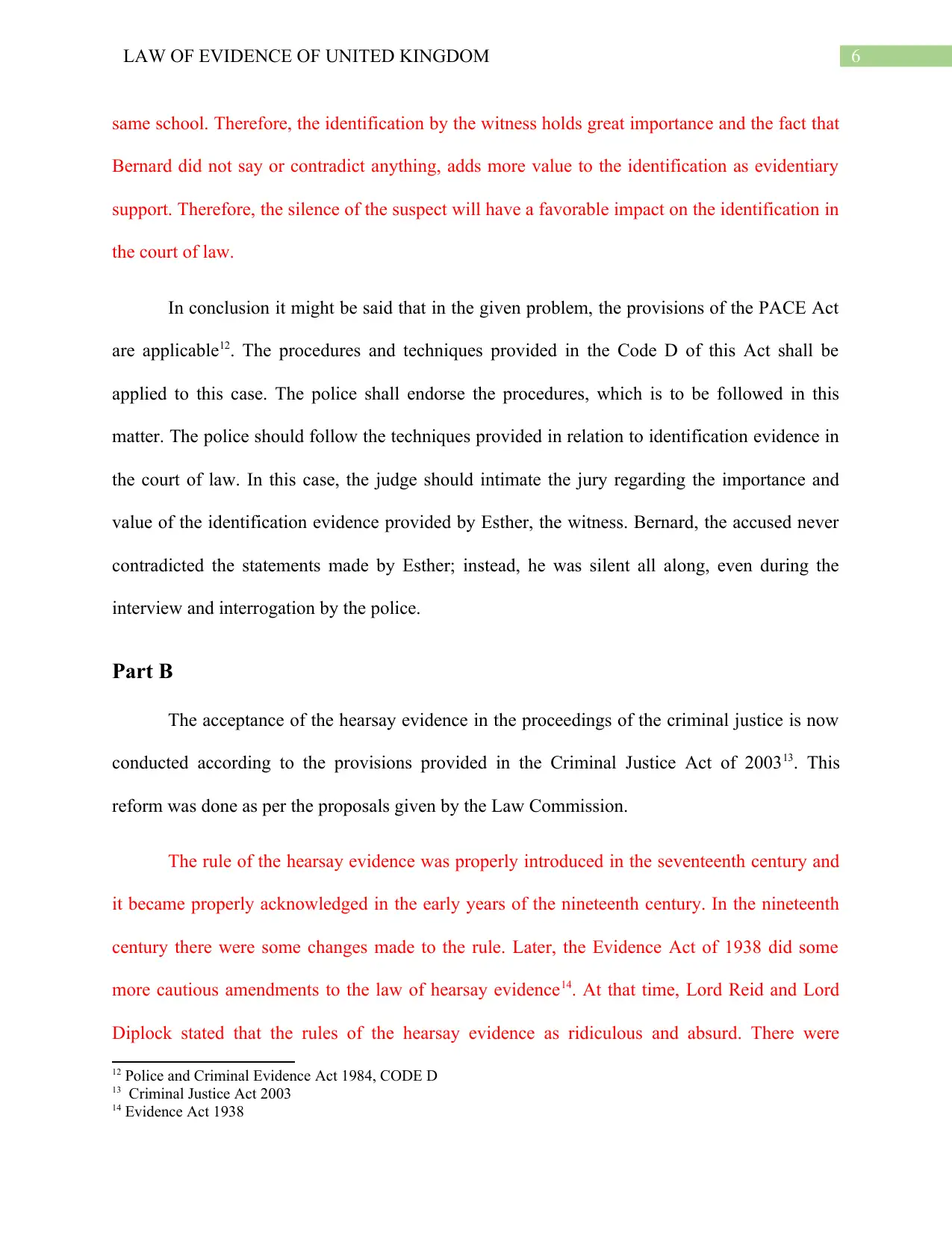
6LAW OF EVIDENCE OF UNITED KINGDOM
same school. Therefore, the identification by the witness holds great importance and the fact that
Bernard did not say or contradict anything, adds more value to the identification as evidentiary
support. Therefore, the silence of the suspect will have a favorable impact on the identification in
the court of law.
In conclusion it might be said that in the given problem, the provisions of the PACE Act
are applicable12. The procedures and techniques provided in the Code D of this Act shall be
applied to this case. The police shall endorse the procedures, which is to be followed in this
matter. The police should follow the techniques provided in relation to identification evidence in
the court of law. In this case, the judge should intimate the jury regarding the importance and
value of the identification evidence provided by Esther, the witness. Bernard, the accused never
contradicted the statements made by Esther; instead, he was silent all along, even during the
interview and interrogation by the police.
Part B
The acceptance of the hearsay evidence in the proceedings of the criminal justice is now
conducted according to the provisions provided in the Criminal Justice Act of 200313. This
reform was done as per the proposals given by the Law Commission.
The rule of the hearsay evidence was properly introduced in the seventeenth century and
it became properly acknowledged in the early years of the nineteenth century. In the nineteenth
century there were some changes made to the rule. Later, the Evidence Act of 1938 did some
more cautious amendments to the law of hearsay evidence14. At that time, Lord Reid and Lord
Diplock stated that the rules of the hearsay evidence as ridiculous and absurd. There were
12 Police and Criminal Evidence Act 1984, CODE D
13 Criminal Justice Act 2003
14 Evidence Act 1938
same school. Therefore, the identification by the witness holds great importance and the fact that
Bernard did not say or contradict anything, adds more value to the identification as evidentiary
support. Therefore, the silence of the suspect will have a favorable impact on the identification in
the court of law.
In conclusion it might be said that in the given problem, the provisions of the PACE Act
are applicable12. The procedures and techniques provided in the Code D of this Act shall be
applied to this case. The police shall endorse the procedures, which is to be followed in this
matter. The police should follow the techniques provided in relation to identification evidence in
the court of law. In this case, the judge should intimate the jury regarding the importance and
value of the identification evidence provided by Esther, the witness. Bernard, the accused never
contradicted the statements made by Esther; instead, he was silent all along, even during the
interview and interrogation by the police.
Part B
The acceptance of the hearsay evidence in the proceedings of the criminal justice is now
conducted according to the provisions provided in the Criminal Justice Act of 200313. This
reform was done as per the proposals given by the Law Commission.
The rule of the hearsay evidence was properly introduced in the seventeenth century and
it became properly acknowledged in the early years of the nineteenth century. In the nineteenth
century there were some changes made to the rule. Later, the Evidence Act of 1938 did some
more cautious amendments to the law of hearsay evidence14. At that time, Lord Reid and Lord
Diplock stated that the rules of the hearsay evidence as ridiculous and absurd. There were
12 Police and Criminal Evidence Act 1984, CODE D
13 Criminal Justice Act 2003
14 Evidence Act 1938
Paraphrase This Document
Need a fresh take? Get an instant paraphrase of this document with our AI Paraphraser
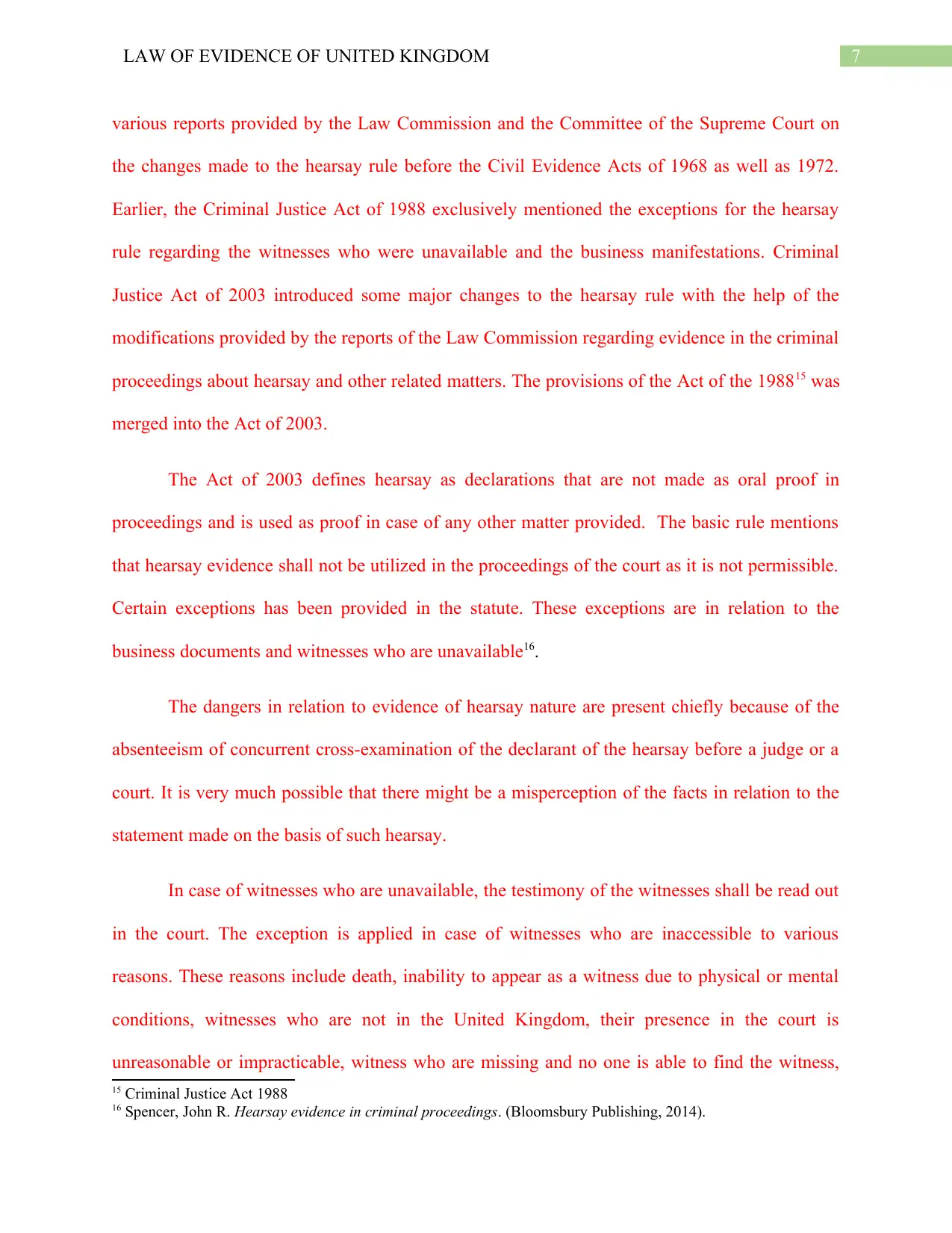
7LAW OF EVIDENCE OF UNITED KINGDOM
various reports provided by the Law Commission and the Committee of the Supreme Court on
the changes made to the hearsay rule before the Civil Evidence Acts of 1968 as well as 1972.
Earlier, the Criminal Justice Act of 1988 exclusively mentioned the exceptions for the hearsay
rule regarding the witnesses who were unavailable and the business manifestations. Criminal
Justice Act of 2003 introduced some major changes to the hearsay rule with the help of the
modifications provided by the reports of the Law Commission regarding evidence in the criminal
proceedings about hearsay and other related matters. The provisions of the Act of the 198815 was
merged into the Act of 2003.
The Act of 2003 defines hearsay as declarations that are not made as oral proof in
proceedings and is used as proof in case of any other matter provided. The basic rule mentions
that hearsay evidence shall not be utilized in the proceedings of the court as it is not permissible.
Certain exceptions has been provided in the statute. These exceptions are in relation to the
business documents and witnesses who are unavailable16.
The dangers in relation to evidence of hearsay nature are present chiefly because of the
absenteeism of concurrent cross-examination of the declarant of the hearsay before a judge or a
court. It is very much possible that there might be a misperception of the facts in relation to the
statement made on the basis of such hearsay.
In case of witnesses who are unavailable, the testimony of the witnesses shall be read out
in the court. The exception is applied in case of witnesses who are inaccessible to various
reasons. These reasons include death, inability to appear as a witness due to physical or mental
conditions, witnesses who are not in the United Kingdom, their presence in the court is
unreasonable or impracticable, witness who are missing and no one is able to find the witness,
15 Criminal Justice Act 1988
16 Spencer, John R. Hearsay evidence in criminal proceedings. (Bloomsbury Publishing, 2014).
various reports provided by the Law Commission and the Committee of the Supreme Court on
the changes made to the hearsay rule before the Civil Evidence Acts of 1968 as well as 1972.
Earlier, the Criminal Justice Act of 1988 exclusively mentioned the exceptions for the hearsay
rule regarding the witnesses who were unavailable and the business manifestations. Criminal
Justice Act of 2003 introduced some major changes to the hearsay rule with the help of the
modifications provided by the reports of the Law Commission regarding evidence in the criminal
proceedings about hearsay and other related matters. The provisions of the Act of the 198815 was
merged into the Act of 2003.
The Act of 2003 defines hearsay as declarations that are not made as oral proof in
proceedings and is used as proof in case of any other matter provided. The basic rule mentions
that hearsay evidence shall not be utilized in the proceedings of the court as it is not permissible.
Certain exceptions has been provided in the statute. These exceptions are in relation to the
business documents and witnesses who are unavailable16.
The dangers in relation to evidence of hearsay nature are present chiefly because of the
absenteeism of concurrent cross-examination of the declarant of the hearsay before a judge or a
court. It is very much possible that there might be a misperception of the facts in relation to the
statement made on the basis of such hearsay.
In case of witnesses who are unavailable, the testimony of the witnesses shall be read out
in the court. The exception is applied in case of witnesses who are inaccessible to various
reasons. These reasons include death, inability to appear as a witness due to physical or mental
conditions, witnesses who are not in the United Kingdom, their presence in the court is
unreasonable or impracticable, witness who are missing and no one is able to find the witness,
15 Criminal Justice Act 1988
16 Spencer, John R. Hearsay evidence in criminal proceedings. (Bloomsbury Publishing, 2014).
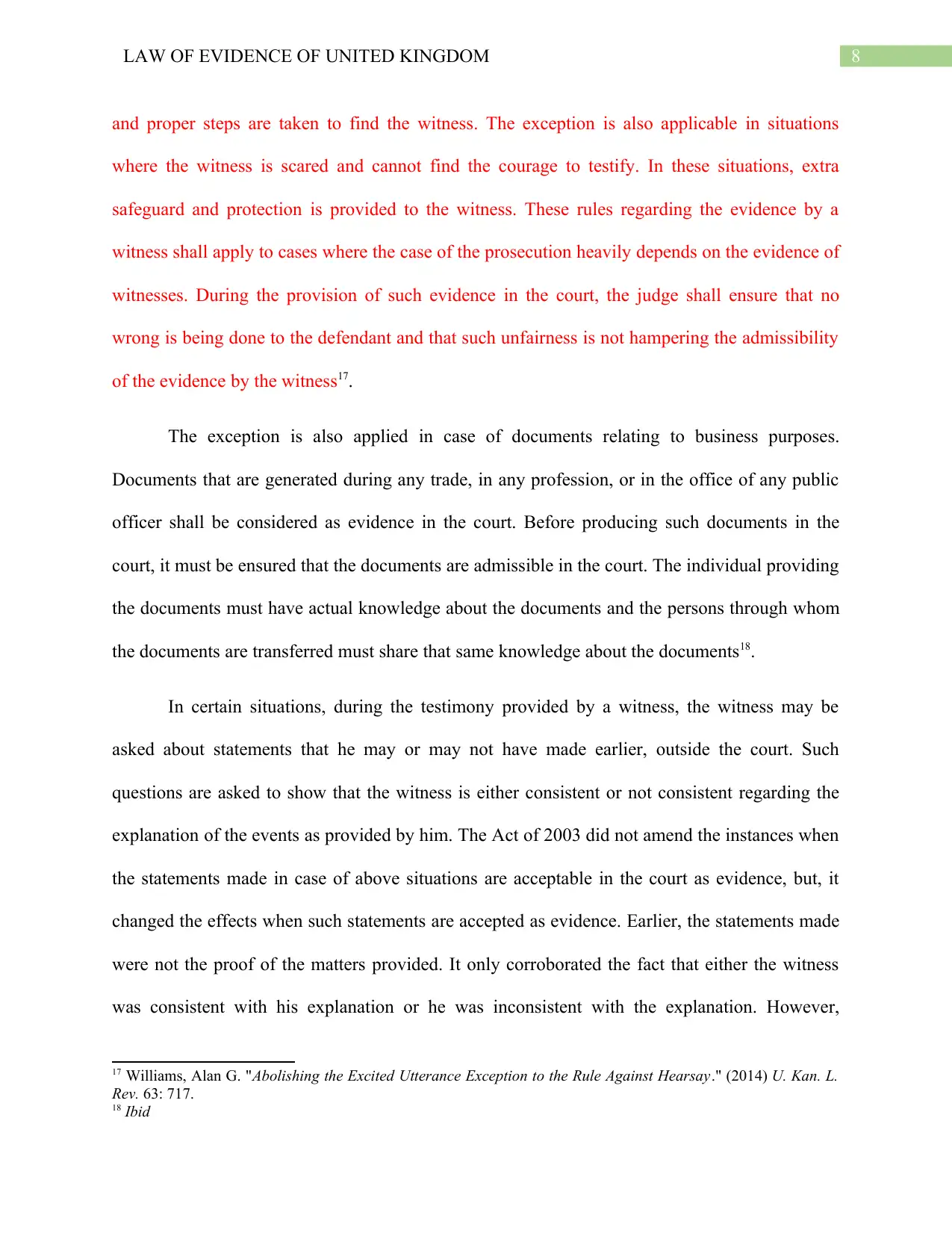
8LAW OF EVIDENCE OF UNITED KINGDOM
and proper steps are taken to find the witness. The exception is also applicable in situations
where the witness is scared and cannot find the courage to testify. In these situations, extra
safeguard and protection is provided to the witness. These rules regarding the evidence by a
witness shall apply to cases where the case of the prosecution heavily depends on the evidence of
witnesses. During the provision of such evidence in the court, the judge shall ensure that no
wrong is being done to the defendant and that such unfairness is not hampering the admissibility
of the evidence by the witness17.
The exception is also applied in case of documents relating to business purposes.
Documents that are generated during any trade, in any profession, or in the office of any public
officer shall be considered as evidence in the court. Before producing such documents in the
court, it must be ensured that the documents are admissible in the court. The individual providing
the documents must have actual knowledge about the documents and the persons through whom
the documents are transferred must share that same knowledge about the documents18.
In certain situations, during the testimony provided by a witness, the witness may be
asked about statements that he may or may not have made earlier, outside the court. Such
questions are asked to show that the witness is either consistent or not consistent regarding the
explanation of the events as provided by him. The Act of 2003 did not amend the instances when
the statements made in case of above situations are acceptable in the court as evidence, but, it
changed the effects when such statements are accepted as evidence. Earlier, the statements made
were not the proof of the matters provided. It only corroborated the fact that either the witness
was consistent with his explanation or he was inconsistent with the explanation. However,
17 Williams, Alan G. "Abolishing the Excited Utterance Exception to the Rule Against Hearsay." (2014) U. Kan. L.
Rev. 63: 717.
18 Ibid
and proper steps are taken to find the witness. The exception is also applicable in situations
where the witness is scared and cannot find the courage to testify. In these situations, extra
safeguard and protection is provided to the witness. These rules regarding the evidence by a
witness shall apply to cases where the case of the prosecution heavily depends on the evidence of
witnesses. During the provision of such evidence in the court, the judge shall ensure that no
wrong is being done to the defendant and that such unfairness is not hampering the admissibility
of the evidence by the witness17.
The exception is also applied in case of documents relating to business purposes.
Documents that are generated during any trade, in any profession, or in the office of any public
officer shall be considered as evidence in the court. Before producing such documents in the
court, it must be ensured that the documents are admissible in the court. The individual providing
the documents must have actual knowledge about the documents and the persons through whom
the documents are transferred must share that same knowledge about the documents18.
In certain situations, during the testimony provided by a witness, the witness may be
asked about statements that he may or may not have made earlier, outside the court. Such
questions are asked to show that the witness is either consistent or not consistent regarding the
explanation of the events as provided by him. The Act of 2003 did not amend the instances when
the statements made in case of above situations are acceptable in the court as evidence, but, it
changed the effects when such statements are accepted as evidence. Earlier, the statements made
were not the proof of the matters provided. It only corroborated the fact that either the witness
was consistent with his explanation or he was inconsistent with the explanation. However,
17 Williams, Alan G. "Abolishing the Excited Utterance Exception to the Rule Against Hearsay." (2014) U. Kan. L.
Rev. 63: 717.
18 Ibid
⊘ This is a preview!⊘
Do you want full access?
Subscribe today to unlock all pages.

Trusted by 1+ million students worldwide
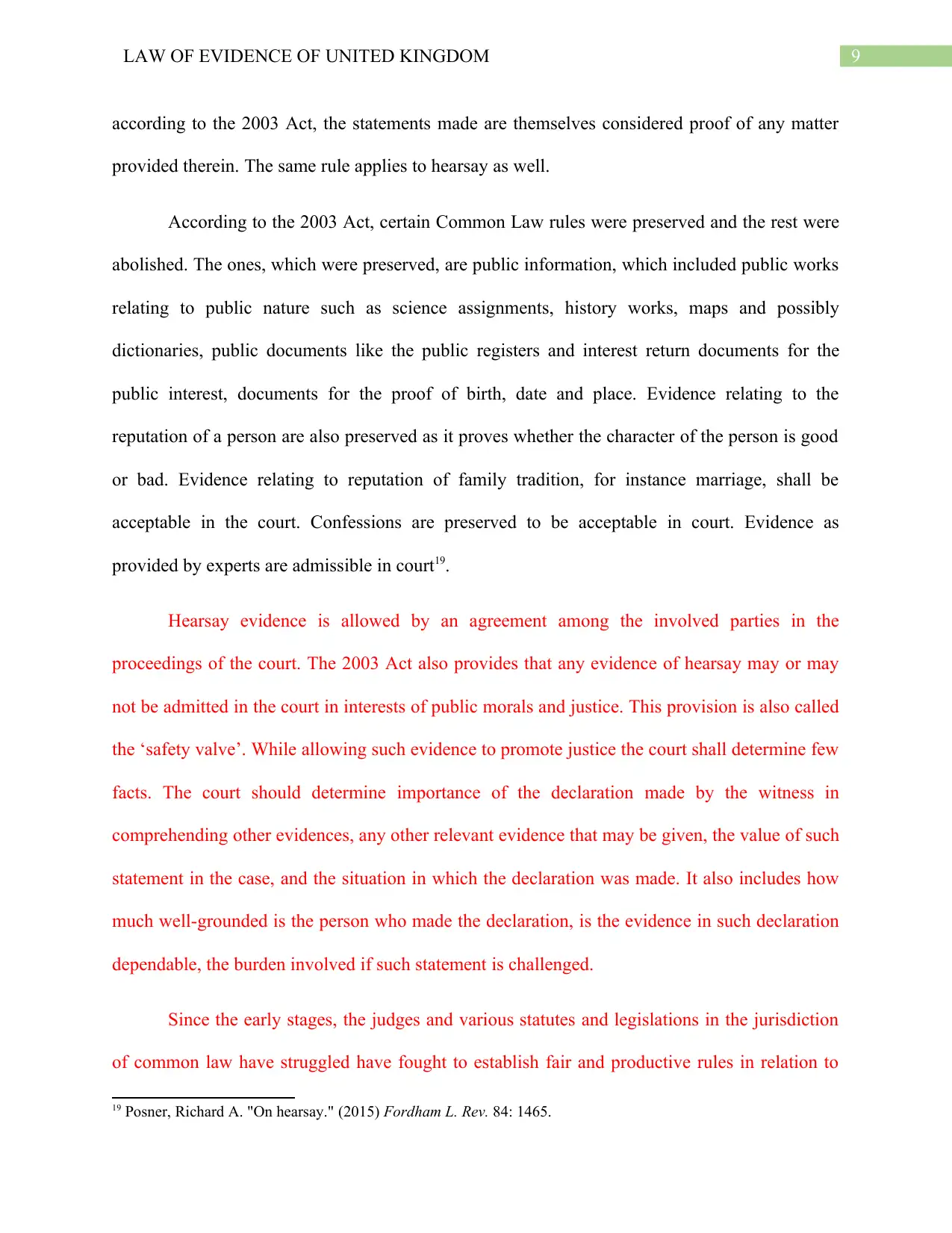
9LAW OF EVIDENCE OF UNITED KINGDOM
according to the 2003 Act, the statements made are themselves considered proof of any matter
provided therein. The same rule applies to hearsay as well.
According to the 2003 Act, certain Common Law rules were preserved and the rest were
abolished. The ones, which were preserved, are public information, which included public works
relating to public nature such as science assignments, history works, maps and possibly
dictionaries, public documents like the public registers and interest return documents for the
public interest, documents for the proof of birth, date and place. Evidence relating to the
reputation of a person are also preserved as it proves whether the character of the person is good
or bad. Evidence relating to reputation of family tradition, for instance marriage, shall be
acceptable in the court. Confessions are preserved to be acceptable in court. Evidence as
provided by experts are admissible in court19.
Hearsay evidence is allowed by an agreement among the involved parties in the
proceedings of the court. The 2003 Act also provides that any evidence of hearsay may or may
not be admitted in the court in interests of public morals and justice. This provision is also called
the ‘safety valve’. While allowing such evidence to promote justice the court shall determine few
facts. The court should determine importance of the declaration made by the witness in
comprehending other evidences, any other relevant evidence that may be given, the value of such
statement in the case, and the situation in which the declaration was made. It also includes how
much well-grounded is the person who made the declaration, is the evidence in such declaration
dependable, the burden involved if such statement is challenged.
Since the early stages, the judges and various statutes and legislations in the jurisdiction
of common law have struggled have fought to establish fair and productive rules in relation to
19 Posner, Richard A. "On hearsay." (2015) Fordham L. Rev. 84: 1465.
according to the 2003 Act, the statements made are themselves considered proof of any matter
provided therein. The same rule applies to hearsay as well.
According to the 2003 Act, certain Common Law rules were preserved and the rest were
abolished. The ones, which were preserved, are public information, which included public works
relating to public nature such as science assignments, history works, maps and possibly
dictionaries, public documents like the public registers and interest return documents for the
public interest, documents for the proof of birth, date and place. Evidence relating to the
reputation of a person are also preserved as it proves whether the character of the person is good
or bad. Evidence relating to reputation of family tradition, for instance marriage, shall be
acceptable in the court. Confessions are preserved to be acceptable in court. Evidence as
provided by experts are admissible in court19.
Hearsay evidence is allowed by an agreement among the involved parties in the
proceedings of the court. The 2003 Act also provides that any evidence of hearsay may or may
not be admitted in the court in interests of public morals and justice. This provision is also called
the ‘safety valve’. While allowing such evidence to promote justice the court shall determine few
facts. The court should determine importance of the declaration made by the witness in
comprehending other evidences, any other relevant evidence that may be given, the value of such
statement in the case, and the situation in which the declaration was made. It also includes how
much well-grounded is the person who made the declaration, is the evidence in such declaration
dependable, the burden involved if such statement is challenged.
Since the early stages, the judges and various statutes and legislations in the jurisdiction
of common law have struggled have fought to establish fair and productive rules in relation to
19 Posner, Richard A. "On hearsay." (2015) Fordham L. Rev. 84: 1465.
Paraphrase This Document
Need a fresh take? Get an instant paraphrase of this document with our AI Paraphraser
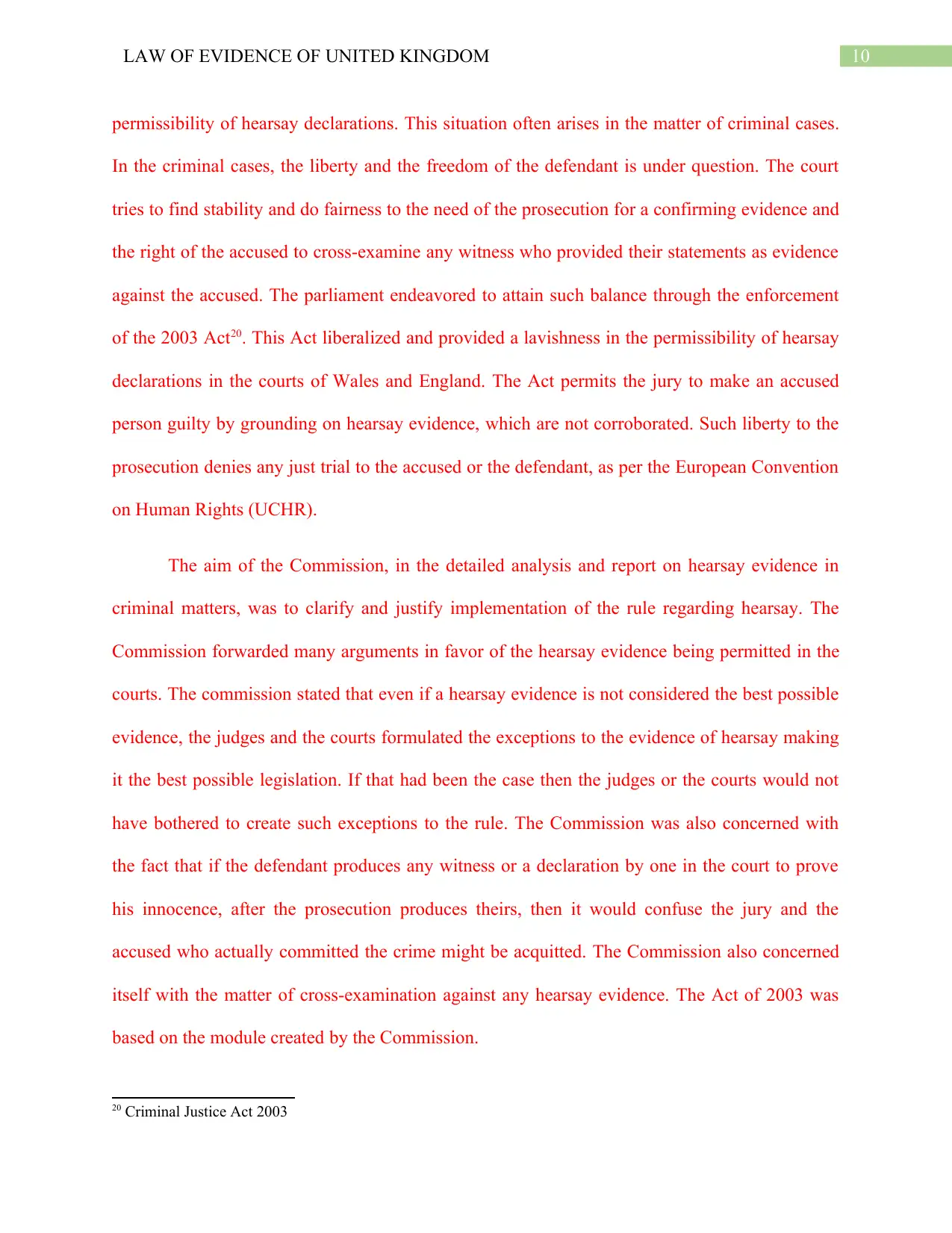
10LAW OF EVIDENCE OF UNITED KINGDOM
permissibility of hearsay declarations. This situation often arises in the matter of criminal cases.
In the criminal cases, the liberty and the freedom of the defendant is under question. The court
tries to find stability and do fairness to the need of the prosecution for a confirming evidence and
the right of the accused to cross-examine any witness who provided their statements as evidence
against the accused. The parliament endeavored to attain such balance through the enforcement
of the 2003 Act20. This Act liberalized and provided a lavishness in the permissibility of hearsay
declarations in the courts of Wales and England. The Act permits the jury to make an accused
person guilty by grounding on hearsay evidence, which are not corroborated. Such liberty to the
prosecution denies any just trial to the accused or the defendant, as per the European Convention
on Human Rights (UCHR).
The aim of the Commission, in the detailed analysis and report on hearsay evidence in
criminal matters, was to clarify and justify implementation of the rule regarding hearsay. The
Commission forwarded many arguments in favor of the hearsay evidence being permitted in the
courts. The commission stated that even if a hearsay evidence is not considered the best possible
evidence, the judges and the courts formulated the exceptions to the evidence of hearsay making
it the best possible legislation. If that had been the case then the judges or the courts would not
have bothered to create such exceptions to the rule. The Commission was also concerned with
the fact that if the defendant produces any witness or a declaration by one in the court to prove
his innocence, after the prosecution produces theirs, then it would confuse the jury and the
accused who actually committed the crime might be acquitted. The Commission also concerned
itself with the matter of cross-examination against any hearsay evidence. The Act of 2003 was
based on the module created by the Commission.
20 Criminal Justice Act 2003
permissibility of hearsay declarations. This situation often arises in the matter of criminal cases.
In the criminal cases, the liberty and the freedom of the defendant is under question. The court
tries to find stability and do fairness to the need of the prosecution for a confirming evidence and
the right of the accused to cross-examine any witness who provided their statements as evidence
against the accused. The parliament endeavored to attain such balance through the enforcement
of the 2003 Act20. This Act liberalized and provided a lavishness in the permissibility of hearsay
declarations in the courts of Wales and England. The Act permits the jury to make an accused
person guilty by grounding on hearsay evidence, which are not corroborated. Such liberty to the
prosecution denies any just trial to the accused or the defendant, as per the European Convention
on Human Rights (UCHR).
The aim of the Commission, in the detailed analysis and report on hearsay evidence in
criminal matters, was to clarify and justify implementation of the rule regarding hearsay. The
Commission forwarded many arguments in favor of the hearsay evidence being permitted in the
courts. The commission stated that even if a hearsay evidence is not considered the best possible
evidence, the judges and the courts formulated the exceptions to the evidence of hearsay making
it the best possible legislation. If that had been the case then the judges or the courts would not
have bothered to create such exceptions to the rule. The Commission was also concerned with
the fact that if the defendant produces any witness or a declaration by one in the court to prove
his innocence, after the prosecution produces theirs, then it would confuse the jury and the
accused who actually committed the crime might be acquitted. The Commission also concerned
itself with the matter of cross-examination against any hearsay evidence. The Act of 2003 was
based on the module created by the Commission.
20 Criminal Justice Act 2003
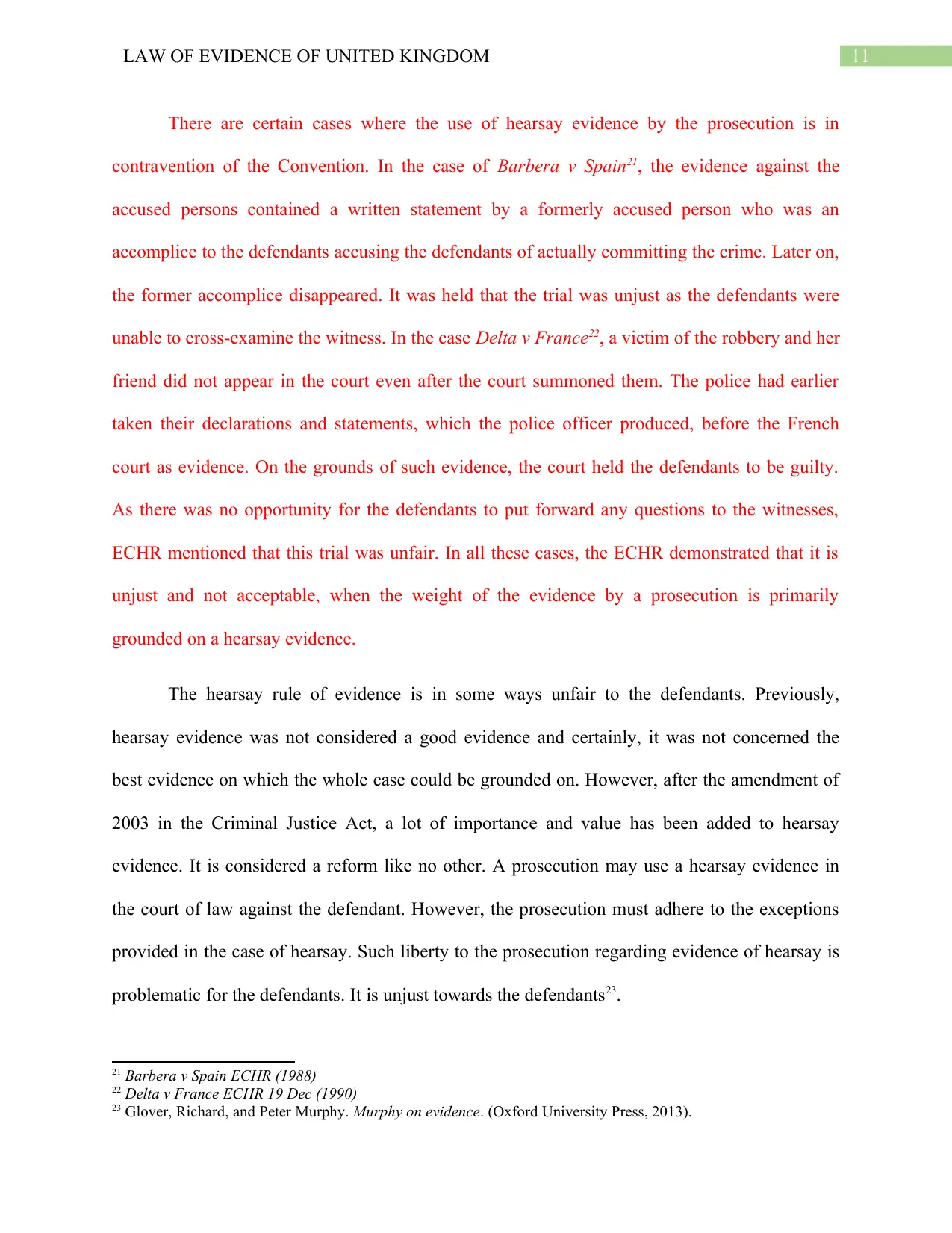
11LAW OF EVIDENCE OF UNITED KINGDOM
There are certain cases where the use of hearsay evidence by the prosecution is in
contravention of the Convention. In the case of Barbera v Spain21, the evidence against the
accused persons contained a written statement by a formerly accused person who was an
accomplice to the defendants accusing the defendants of actually committing the crime. Later on,
the former accomplice disappeared. It was held that the trial was unjust as the defendants were
unable to cross-examine the witness. In the case Delta v France22, a victim of the robbery and her
friend did not appear in the court even after the court summoned them. The police had earlier
taken their declarations and statements, which the police officer produced, before the French
court as evidence. On the grounds of such evidence, the court held the defendants to be guilty.
As there was no opportunity for the defendants to put forward any questions to the witnesses,
ECHR mentioned that this trial was unfair. In all these cases, the ECHR demonstrated that it is
unjust and not acceptable, when the weight of the evidence by a prosecution is primarily
grounded on a hearsay evidence.
The hearsay rule of evidence is in some ways unfair to the defendants. Previously,
hearsay evidence was not considered a good evidence and certainly, it was not concerned the
best evidence on which the whole case could be grounded on. However, after the amendment of
2003 in the Criminal Justice Act, a lot of importance and value has been added to hearsay
evidence. It is considered a reform like no other. A prosecution may use a hearsay evidence in
the court of law against the defendant. However, the prosecution must adhere to the exceptions
provided in the case of hearsay. Such liberty to the prosecution regarding evidence of hearsay is
problematic for the defendants. It is unjust towards the defendants23.
21 Barbera v Spain ECHR (1988)
22 Delta v France ECHR 19 Dec (1990)
23 Glover, Richard, and Peter Murphy. Murphy on evidence. (Oxford University Press, 2013).
There are certain cases where the use of hearsay evidence by the prosecution is in
contravention of the Convention. In the case of Barbera v Spain21, the evidence against the
accused persons contained a written statement by a formerly accused person who was an
accomplice to the defendants accusing the defendants of actually committing the crime. Later on,
the former accomplice disappeared. It was held that the trial was unjust as the defendants were
unable to cross-examine the witness. In the case Delta v France22, a victim of the robbery and her
friend did not appear in the court even after the court summoned them. The police had earlier
taken their declarations and statements, which the police officer produced, before the French
court as evidence. On the grounds of such evidence, the court held the defendants to be guilty.
As there was no opportunity for the defendants to put forward any questions to the witnesses,
ECHR mentioned that this trial was unfair. In all these cases, the ECHR demonstrated that it is
unjust and not acceptable, when the weight of the evidence by a prosecution is primarily
grounded on a hearsay evidence.
The hearsay rule of evidence is in some ways unfair to the defendants. Previously,
hearsay evidence was not considered a good evidence and certainly, it was not concerned the
best evidence on which the whole case could be grounded on. However, after the amendment of
2003 in the Criminal Justice Act, a lot of importance and value has been added to hearsay
evidence. It is considered a reform like no other. A prosecution may use a hearsay evidence in
the court of law against the defendant. However, the prosecution must adhere to the exceptions
provided in the case of hearsay. Such liberty to the prosecution regarding evidence of hearsay is
problematic for the defendants. It is unjust towards the defendants23.
21 Barbera v Spain ECHR (1988)
22 Delta v France ECHR 19 Dec (1990)
23 Glover, Richard, and Peter Murphy. Murphy on evidence. (Oxford University Press, 2013).
⊘ This is a preview!⊘
Do you want full access?
Subscribe today to unlock all pages.

Trusted by 1+ million students worldwide
1 out of 15
Related Documents
Your All-in-One AI-Powered Toolkit for Academic Success.
+13062052269
info@desklib.com
Available 24*7 on WhatsApp / Email
![[object Object]](/_next/static/media/star-bottom.7253800d.svg)
Unlock your academic potential
Copyright © 2020–2025 A2Z Services. All Rights Reserved. Developed and managed by ZUCOL.





